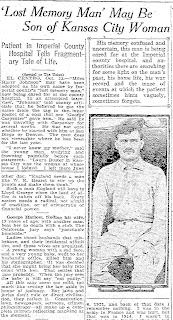Now and again there occur alterations of the ‘emotional’ and the “apparently normal” personalities, the return of the former often heralded by severe headache, dizziness or by a hysterical convulsion. —Charles S. Myers, Shell Shock in France, 1914-1918: Based on a War Diary
By the time the United States was dragged into Europe’s war in April of 1917, over 370 Busters had registered for the draft.
While half a dozen were either killed in action or died from diseases, twice as many died between their forties and early sixties, their lives cut down at least ten years from than the average male of their time. Not only could stress create long term physical damages brought on by alcoholism, heart disease, and suicide, recent studies also suggest trauma has been linked to accelerated aging.
A few other Buster women became artists, such as Winfred Buster who was a local actor involved in entertaining wounded WWI soldiers at the base. By 1922, entertaining and supporting survivors of WWI, and Winfred in San Francisco was one of them. Meanwhile, other Busters dealt with the lingering aftermath of war. By the time Winfred made local headlines in July, three months later, another Buster would make headlines for an entirely different reason.
The precise number of Busters who suffered from PTSD and/or “shell shock” is uncharted; however, a third had made the newspaper once more, this time, recognized as the “Lost Memory Man.” Great-grandson of William Jr., twenty-two-year-old Charley Roy Buster born from rural town Perry, Kansas, in between Topeka and Lawrence, moved to Kansas City, Kansas, where he worked for Rock Island Railroad as a trucker before enlisting as a private.
He was drafted in June of 1917 and finished in April of 1919. The two pieces of evidence that survived from the 1973 St. Louis records fire were his draft card and veteran headstone application; his discharged papers did not. The San Diego Union newspaper stated he served in the American Expeditionary Forces, or the AEF.
One month entering the war, Maj. Gen. John Pershing was pulled from the Mexican Revolution out of Texas to command the AEF in France. The 41st Infantry, which Charley was assigned to, was meshed together with the National Guards from the Pacific West and Midwest during the summer, and arrived in Europe by November. As part of the AEF, Charley would have been a part of the Aisne Offensive on the Western Front, enduring trench and chemical warfare. His short stature didn’t prevent him from serving; only needing to be strong, healthy, and able to march as well as pull the trigger. He had been noted for being at the Argonne Battle in 1918, France’s last series of its most brutal battles. The war was far from winding down, and the Meuse-Argonne Offensive desperately needed replacements with its third attempt to break through the German lines near Belgium. Beginning in late summer, it was the largest offensive in United States military history, involving 1.2 million American soldiers, where three Busters were killed, including Enoch, son of Loyalty Ranger, John.
Charley’s regiment merged with the 41st Infantry, 10th Division, coming from Camp Funston, Kansas in September of 1918. As a newly constructed boot camp in Riley County, Kansas, Camp Funston was one of sixteen training camps across the country that developed from a necessity to train farmers and laborers into soldiers. Camp Funston was known for two momentous facts: The first was preserving the Buffalo soldier tradition, historically celebrated by Black American soldiers on the prairie, the next generation was trained to fight overseas, even if in a segregated section. And secondly, as many historians have concluded, was the hot spot which spread the Influenza pandemic worldwide. The first men reported with the illness came from Haskell County, Kansas, and appeared to pass the flu-like symptoms to others. Whether Charley had been among them is difficult to verify, but about forty-five thousand American soldiers had died from influenza and pneumonia related symptoms, making up almost 40% of their deaths during the war.
 The photo revealed a young man with a square jawline and broad nose, a fashionable Clark Gable mustache, his eyes slightly uneven. The paper went on: “His memory confused and uncertain, this man being cared for at the Imperial County Hospital, and authorities are searching for some light on the man’s past, his home life, his war record, and the maze of events at which the patient sometimes hints vaguely, sometimes forgets.”
The photo revealed a young man with a square jawline and broad nose, a fashionable Clark Gable mustache, his eyes slightly uneven. The paper went on: “His memory confused and uncertain, this man being cared for at the Imperial County Hospital, and authorities are searching for some light on the man’s past, his home life, his war record, and the maze of events at which the patient sometimes hints vaguely, sometimes forgets.”

